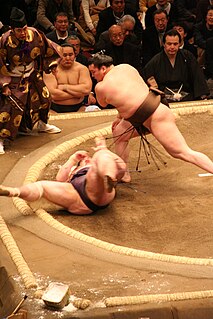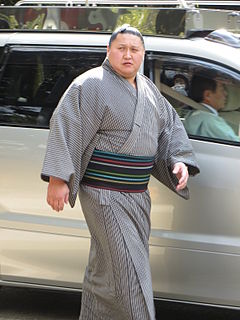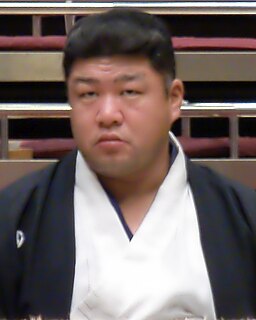
Makuuchi (幕内) or makunouchi (幕の内), is the top division of the six divisions of professional sumo. Its size is fixed at 42 wrestlers (rikishi), ordered into five ranks according to their ability as defined by their performance in previous tournaments.

Toshimitsu Obata known as Kitanoumi Toshimitsu (北の湖敏満), was a sumo wrestler. He was the dominant yokozuna in sumo during the 1970s. Kitanoumi was promoted to yokozuna at the age 21, becoming the youngest ever to achieve sumo's top rank, and he remained a yokozuna for a record 63 tournaments. He won 24 tournament championships during his career and was one of a series of truly great yokozuna who came from Hokkaidō, the northernmost main island of Japan. At the time of his death he still held the record for most bouts won as a yokozuna (670). Following his retirement in 1985 he established the Kitanoumi stable. He was chairman of the Japan Sumo Association from 2002 until 2008, and from 2012 until his death.

Futabayama Sadaji, born as Akiyoshi Sadaji in Oita Prefecture, Japan, was the 35th yokozuna in sumo wrestling, from 1937 until 1945. He won twelve yūshō or top division championships and had a winning streak of 69 consecutive bouts, an all-time record. Despite his dominance he was extremely popular with the public. After his retirement he was head coach of Tokitsukaze stable and chairman of the Japan Sumo Association.
Takamiyama Daigorō is a former sumo wrestler, the first foreign-born wrestler to win the top division championship. His highest rank was sekiwake. His active career spanned twenty years from 1964 to 1984, and he set a number of longevity records, including most tournaments ranked in the top makuuchi division, and most consecutive top division appearances. He is also the first foreign-born wrestler ever to take charge of a training stable, founding Azumazeki stable in 1986. His most successful wrestler was fellow Hawaiian Akebono who reached the highest rank of yokozuna in 1993. He retired as a coach in 2009.

Baruto Kaito is a politician and former professional sumo wrestler from Estonia. Making his debut in May 2004, he reached the top division after just two years in sumo in May 2006. After suffering a number of injury problems in 2007 which delayed his progress, he reached the third-highest rank of sekiwake in November 2008, and was promoted to ōzeki rank after finishing the March 2010 tournament with a score of 14–1. He was a tournament runner-up four times before recording a top division championship in the 2012 January tournament. During his career Baruto also earned five special prizes for Fighting Spirit, one for Outstanding Performance and one for Technique. He lost his ōzeki rank after more injury problems at the end of 2012, and having fallen greatly in rank after withdrawing from the May 2013 tournament, he announced his retirement in September of that year at the age of 28.

Kyokutenhō Masaru in Nalaikh, Ulan Bator, Mongolia is a former professional sumo wrestler. He made his debut in March 1992 out of Ōshima stable, with the first group of Mongolians ever to join the sport in Japan, reaching the top makuuchi division in January 1998. In his exceptionally long career he received seven special prizes for Fighting Spirit, and won one yūshō, in May 2012 from the maegashira ranks, which made him at 37 the oldest first–time yūshō winner in sumo history, and he was runner-up in one other tournament. His highest rank was sekiwake, which he held on three occasions. He was the first wrestler since the 1950s to be ranked in the top division after the age of 40. He made more appearances in the top division than any other wrestler at 1470, and only Ōshio fought more than his 1870 career bouts. He announced his retirement in July 2015 and declared his intention to stay in sumo as an elder, having acquired Japanese citizenship in 2005. In 2017 he became the head coach of Tomozuna stable and he is known as Tomozuna-oyakata.

Kaiō Hiroyuki is a former professional sumo wrestler from Nōgata, Fukuoka, Japan.

Kitanofuji Katsuaki 北の富士勝昭 is a former sumo wrestler, born in Asahikawa, Hokkaidō, Japan. He was the sport's 52nd yokozuna. He was also the head coach of Kokonoe stable.

Ōnokuni Yasushi is a former sumo wrestler from Hokkaidō, Japan. Making his professional debut in 1978, he reached the top division in 1983. In 1987 he won his first yūshō or tournament championship with a perfect score and became the sport's 62nd yokozuna. However, he was able to win only one more championship before his retirement in 1991. He has remained in sumo as a coach and in 1999 became the head of Shibatayama stable. He was elected to the Japan Sumo Association's board of directors in 2018. His peak weight was 210 kg (463 lbs) in May 1989.

Hokutoumi Nobuyoshi is a former sumo wrestler from Hokkaidō, Japan. He is the sport's 61st yokozuna and won eight top division championships. He wrestled for Kokonoe stable, as did yokozuna Chiyonofuji, and the two were the first yokozuna stablemates to take part in a play-off for the championship, in 1989. After a number of injury problems he retired in 1992, and is now the head coach of Hakkaku stable. In November 2015 he was appointed the chairman of the Japan Sumo Association, following the death of Kitanoumi, initially to serve until the end of March 2016. He was then elected as head for a full term by his fellow board members in a vote held on March 28, 2016, and re-elected in 2018.
Takatōriki Tadashige is a former sumo wrestler and professional wrestler from Kobe, Japan. He made his professional debut in 1983, reaching the top division in 1990. His highest rank was sekiwake. Known for his great fighting spirit, he won 14 tournament prizes, including a record ten Kantō-shō, and earned nine gold stars for defeating yokozuna ranked wrestlers. He wrestled for the highly successful Futagoyama stable. He was twice runner-up in top division tournaments and in March 2000, from the maegashira ranks, he unexpectedly won the yūshō or championship. He retired in 2002 and became the head coach of Ōtake stable, having married the daughter of the previous owner of the heya, the great yokozuna Taihō. However, he was dismissed from the Sumo Association in 2010 for his role in an illegal gambling scandal.

Musōyama Masashi is a former sumo wrestler from Mito, Ibaraki, Japan. A former amateur champion, he turned professional in January 1993, and he won promotion to the top makuuchi division in just four tournaments. He won thirteen special prizes and spent a total of 31 tournaments at komusubi and sekiwake before finally reaching the second highest rank of ōzeki in 2000, shortly after winning his only top division tournament championship or yūshō. He retired in 2004. He is now the head coach of Fujishima stable.

Tokitenkū Yoshiaki was a sumo wrestler.
Professional sumo is divided into six ranked divisions. Wrestlers are promoted and demoted within and between these divisions based on the merit of their win/loss records in official tournaments. For more information see kachi-koshi and make-koshi. Wrestlers are also ranked within each division. The higher a wrestler's rank within a division is, the stronger the general level of opponents he will have to face becomes. According to tradition, each rank is further subdivided into East and West, with East being slightly more prestigious, and ranked slightly higher than its West counterpart. The divisions, ranked in order of hierarchy from highest to lowest, are as follows:

Wakashimazu Mutsuo is a Japanese former sumo wrestler from Nakatane, Kagoshima, Japan. His highest rank was ōzeki. He won two top division yūshō or tournament championships. He retired in 1987 and is now the head coach of Nishonoseki stable.
Kotokaze Kōki is a former sumo wrestler from Tsu, Mie, Japan. Beginning his career in 1971, he reached the top makuuchi division in 1977 but after a serious injury in 1979 he fell greatly in rank before staging a comeback. His highest rank was ōzeki, which he reached in 1981. He won two tournament championships and was a runner-up in two others. He won six special prizes and six gold stars for defeating yokozuna. He retired in 1985 and became an elder of the Japan Sumo Association and the head coach of Oguruma stable.

Tochinowaka Kiyotaka is a former sumo wrestler from Wakayama Prefecture, Japan. A former amateur champion, he turned professional in 1985, reaching the top makuuchi division in 1987. His highest rank was sekiwake. He was a runner-up in one tournament and earned six special prizes and four kinboshi. After 76 tournaments and 1114 bouts in the top division he retired in 1999. He is now an elder of the Japan Sumo Association and the head coach of Kasugano stable.

Musashimaru Kōyō is a former sumo wrestler. He made his professional debut in 1989, and reached the top makuuchi division in 1991. After reaching ozeki rank in 1994 his progress seemed to stall, but in 1999 he became the second foreign-born wrestler in history to reach the rank of yokozuna. He won over 700 top division bouts and took twelve top division tournament championships during his career. Musashimaru's sheer 235 kg (518 lb) bulk combined with 1.92 m of height made him a formidable opponent, and he was remarkably consistent and injury-free for most of his career. An amiable personality, his fan base was helped by a surprising facial resemblance to Japanese warrior hero Saigō Takamori. After retiring in 2003, he became an elder of the Japan Sumo Association and founded the Musashigawa stable in 2013.

Sōkokurai Eikichi is a professional sumo wrestler from Inner Mongolia, China. He is the only Chinese national to reach the top makuuchi division. Sōkokurai is of Mongolian descent. He made his professional debut in 2003 and was promoted to the top division in September, 2010. In April 2011 he was ordered to retire by the Japan Sumo Association after being found guilty of involvement in match-fixing. Refusing to do so, he was dismissed. However, in March 2013 his dismissal was nullified by the Tokyo District Court and after the Sumo Association decided not to appeal the decision he reappeared on the banzuke in July 2013 at the Nagoya Basho, ranked as a maegashira 15, the rank he was at when he was expelled. His highest rank to date of maegashira 2 was achieved in March 2017. He has won one special prize for Technique and one gold star for beating a yokozuna.



















